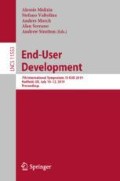Abstract
Recent research invites children to be the protagonists of the design of novel smart nature ecosystems for them. Games and card-based workshops can help engage them in co-design and serve as a tool for generating ideas and designing new concepts. The SNaP game is a collaborative card-based board game that aims at engaging 11–14 years old children as protagonists in the design of novel smart nature ecosystems. This paper outlines the main features of the game, the workshops it was used in and the resulting reflections.
Access this chapter
Tax calculation will be finalised at checkout
Purchases are for personal use only
References
Angelini, L., Mugellini, E., Couture, N., Abou Khaled, O.: Designing the interaction with the internet of tangible things: a card set. In: Proceedings of the Twelfth International Conference on Tangible, Embedded, and Embodied Interaction, TEI 2018, pp. 299–306. ACM, New York (2018). https://doi.org/10.1145/3173225.3173288
Brandt, E.: Designing exploratory design games: a framework for participation in participatory design? In: Proceedings of the Ninth Conference on Participatory Design: Expanding Boundaries in Design, PDC 2006, vol. 1, pp. 57–66. ACM, New York (2006). https://doi.org/10.1145/1147261.1147271
Dibitonto, M., Tazzi, F., Leszczynska, K., Medaglia, C.M.: The IoT design deck: a tool for the co-design of connected products. In: Ahram, T., Falcão, C. (eds.) AHFE 2017. AISC, vol. 607, pp. 217–227. Springer, Cham (2018). https://doi.org/10.1007/978-3-319-60492-3_21
Druin, A.: The role of children in the design of new technology. Behav. Inf. Technol. 21, 1–25 (2002)
Gennari, R., Matera, M., Melonio, A., Roumelioti, E.: A board-game for co-designing smart nature environments in workshops with children. In: End-User Development. Springer, Cham (2019)
Gennari, R., Melonio, A., Matera, M., Roumelioti, E.: A board game and a workshop for co-creating smart nature ecosystems. In: Methodologies and Intelligent Systems for Technology Enhanced Learning. Springer, Cham (2019)
Gennari, R., Melonio, A., Rizvi, M., Bonani, A.: Design of IOT tangibles for primary schools: a case study. In: Proceedings of the 12th Biannual Conference on Italian SIGCHI Chapter, CHItaly 2017, pp. 26:1–26:6. ACM, New York (2017). https://doi.org/10.1145/3125571.3125591
Iivari, N., Kinnula, M.: Empowering children through design and making: towards protagonist role adoption. In: Proceedings of the 15th Participatory Design Conference: Full Papers-Volume 1, PDC 2018, pp. 16:1–16:12. ACM, New York (2018). https://doi.org/10.1145/3210586.3210600
Iversen, O.S., Smith, R.C., Dindler, C.: Child as protagonist: expanding the role of children in participatory design. In: Proceedings of the 2017 Conference on Interaction Design and Children, IDC 2017, pp. 27–37. ACM, New York (2017). https://doi.org/10.1145/3078072.3079725
Kinnula, M., Iivari, N., Isomursu, M., Kinnula, H.: Socializers, achievers or both? Value-based roles of children in technology design projects. Int. J. Child-Comput. Interact. 17, 39–49 (2018). https://doi.org/10.1016/j.ijcci.2018.04.004
Mavroudi, A., Divitini, M., Gianni, F., Mora, S., Kvittem, D.R.: Designing IOT applications in lower secondary schools. In: 2018 IEEE Global Engineering Education Conference (EDUCON), pp. 1120–1126, April 2018. https://doi.org/10.1109/EDUCON.2018.8363355
Mora, S., Gianni, F., Divitini, M.: Tiles: a card-based ideation toolkit for the Internet of Things. In: Proceedings of the 2017 Conference on Designing Interactive Systems, DIS 2017, pp. 587–598. ACM, New York (2017). https://doi.org/10.1145/3064663.3064699
Salen, K., Zimmerman, E.: Rules of Play: Game Design Fundamentals. The MIT Press, Cambridge (2003)
Schell, J.: The Art of Game Design: A Book of Lenses. Morgan Kaufmann Publishers Inc., San Francisco (2008)
Acknowledgements
Our thanks go to all participating children, as well as to the financial support of GeKI and SOfAA from the Free University of Bozen-Bolzano.
Author information
Authors and Affiliations
Corresponding author
Editor information
Editors and Affiliations
Rights and permissions
Copyright information
© 2019 Springer Nature Switzerland AG
About this paper
Cite this paper
Gennari, R., Matera, M., Melonio, A., Roumelioti, E. (2019). Research on Making Nature Smart with Children. In: Malizia, A., Valtolina, S., Morch, A., Serrano, A., Stratton, A. (eds) End-User Development. IS-EUD 2019. Lecture Notes in Computer Science(), vol 11553. Springer, Cham. https://doi.org/10.1007/978-3-030-24781-2_25
Download citation
DOI: https://doi.org/10.1007/978-3-030-24781-2_25
Published:
Publisher Name: Springer, Cham
Print ISBN: 978-3-030-24780-5
Online ISBN: 978-3-030-24781-2
eBook Packages: Computer ScienceComputer Science (R0)

